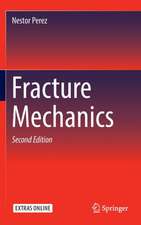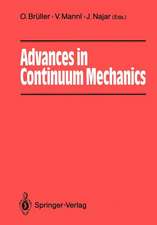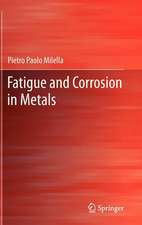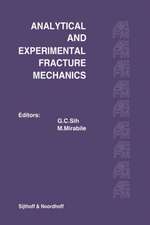Problems of Fracture Mechanics and Fatigue: A Solution Guide
Editat de E.E. Gdoutos, C.A. Rodopoulos, J.R. Yatesen Limba Engleză Paperback – dec 2010
| Toate formatele și edițiile | Preț | Express |
|---|---|---|
| Paperback (1) | 960.13 lei 6-8 săpt. | |
| SPRINGER NETHERLANDS – dec 2010 | 960.13 lei 6-8 săpt. | |
| Hardback (1) | 967.40 lei 6-8 săpt. | |
| SPRINGER NETHERLANDS – 30 noi 2003 | 967.40 lei 6-8 săpt. |
Preț: 960.13 lei
Preț vechi: 1170.89 lei
-18% Nou
Puncte Express: 1440
Preț estimativ în valută:
183.75€ • 191.33$ • 155.29£
183.75€ • 191.33$ • 155.29£
Carte tipărită la comandă
Livrare economică 07-21 martie
Preluare comenzi: 021 569.72.76
Specificații
ISBN-13: 9789048164912
ISBN-10: 9048164915
Pagini: 648
Ilustrații: XXV, 618 p.
Dimensiuni: 155 x 235 x 38 mm
Greutate: 0.87 kg
Ediția:2003
Editura: SPRINGER NETHERLANDS
Colecția Springer
Locul publicării:Dordrecht, Netherlands
ISBN-10: 9048164915
Pagini: 648
Ilustrații: XXV, 618 p.
Dimensiuni: 155 x 235 x 38 mm
Greutate: 0.87 kg
Ediția:2003
Editura: SPRINGER NETHERLANDS
Colecția Springer
Locul publicării:Dordrecht, Netherlands
Public țintă
ResearchCuprins
Problem 1: Airy Stress Function Method.- Problem 2: Westergaard Method for a Crack Under Concentrated Forces.- Problem 3: Westergaard Method for a Periodic Array of Cracks Under Concentrated Forces.- Problem 4: Westergaard Method for a Periodic Array of Cracks Under Uniform Stress.- Problem 5: Calculation of Stress Intensity Factors by the Westergaard Method.- Problem 6: Westergaard Method for a Crack Under Distributed Forces.- Problem 7: Westergaard Method for a Crack Under Concentrated Forces.- Problem 8: Westergaard Method for a Crack Problem.- Problem 9: Westergaard Method for a Crack Subjected to Shear Forces.- Problem 10: Calculation of Stress Intensity Factors by Superposition.- Problem 11: Calculation of Stress Intensity Factors by Integration.- Problem 12: Stress Intensity Factors for a Linear Stress Distribution.- Problem 13: Mixed-Mode Stress Intensity Factors in Cylindrical Shells.- Problem 14: Photoelastic Determination of Stress Intensity Factor KI.- Problem 15: Photoelastic Determination of Mixed-Mode Stress Intensity Factors KI and KII.- Problem 16: Application of the Method of Weight Function for the Determination of Stress Intensity Factors.- Problem 17: Approximate Determination of the Crack Tip Plastic Zone for Mode-I and Mode-II Loading.- Problem 18: Approximate Determination of the Crack Tip Plastic Zone for Mixed-Mode Loading.- Problem 19: Approximate Determination of the Crack Tip Plastic Zone According to the Tresca Yield Criterion.- Problem 20: Approximate Determination of the Crack Tip Plastic Zone According to a Pressure Modified Mises Yield Criterion.- Problem 21: Crack Tip Plastic Zone According to Irwin’s Model.- Problem 22: Effective Stress Intensity factor According to Irwin’s Model.- Problem 23: Plastic Zone at the Tip of aSemi-Infinite Crack According to the Dugdale Model.- Problem 24: Mode-III Crack Tip Plastic Zone According to the Dugdale Model.- Problem 25: Plastic Zone at the Tip of a Penny-Shaped Crack According to the Dugdale Model.- Problem 26: Calculation of Strain Energy Release Rate from Load — Displacement — Crack Area Equation.- Problem 27: Calculation of Strain Energy Release Rate for Deformation Modes I, II and III.- Problem 28: Compliance of a Plate with a Central Crack.- Problem 29: Strain Energy Release Rate for a Semi-Infinite Plate with a Crack.- Problem 30: Strain Energy Release Rate for the Short Rod Specimen.- Problem 31: Strain Energy Release Rate for the Blister Test.- Problem 32: Calculation of Stress Intensity Factors Based on Strain Energy Release Rate.- Problem 33: Critical Strain Energy Release Rate.- Problem 34: Experimental Determination of Critical Stress Intensity Factor KIc.- Problem 35: Experimental Determination of KIc.- Problem 36: Crack Stability.- Problem 37: Stable Crack Growth Based on the Resistance Curve Method.- Problem 38: Three-Point Bending Test in Brittle Materials.- Problem 39: Three-Point Bending Test in Quasi Brittle Materials.- Problem 40: Double-Cantilever Beam Test in Brittle Materials.- Problem 41: Design of a Pressure Vessel.- Problem 42: Thermal Loads in a Pipe.- Problem 43: J-integral for an Elastic Beam Partly Bonded to a Half-Plane.- Problem 44: J-integral for a Strip with a Semi-Infinite Crack.- Problem 45: J-integral for Two Partly Bonded Layers.- Problem 46: J-integral for Mode-I.- Problem 47: J-integral for Mode III.- Problem 48: Path Independent Integrals.- Problem 49: Stresses Around Notches.- Problem 50: Experimental Determination of JIc from J — Crack Growth Curves.- Problem 51: Experimental Determination of Jfrom Potential Energy — Crack Length Curves.- Problem 52: Experimental Determination of J from Load-Displacement Records.- Problem 53: Experimental Determination of J from a Compact Tension Specimen.- Problem 54: Validity of JIc and KIc Tests.- Problem 55: Critical Crack Opening Displacement.- Problem 56: Crack Opening Displacement Design Methodology.- Problem 57: Critical Fracture Stress of a Plate with an Inclined Crack.- Problem 58: Critical Crack Length of a Plate with an Inclined Crack.- Problem 59: Failure of a Plate with an Inclined Crack.- Problem 60: Growth of a Plate with an Inclined Crack Under Biaxial Stresses.- Problem 61: Crack Growth Under Mode-II Loading.- Problem 62: Growth of a Circular Crack Loaded Perpendicularly to its Cord by Tensile Stress.- Problem 63: Growth of a Circular Crack Loaded Perpendicular to its Cord by Compressive Stress.- Problem 64: Growth of a Circular Crack Loaded Parallel to its Cord.- Problem 65: Growth of Radial Cracks Emanating from a Hole.- Problem 66: Strain Energy Density in Cuspidal Points of Rigid Inclusions.- Problem 67: Failure from Cuspidal Points of Rigid Inclusions.- Problem 68: Failure of a Plate with a Hypocycloidal Inclusion.- Problem 69: Crack Growth From Rigid Rectilinear Inclusions.- Problem 70: Crack Growth Under Pure Shear.- Problem 71: Critical Stress in Mixed Mode Fracture.- Problem 72: Critical Stress for an Interface Crack.- Problem 73: Failure of a Pressure Vessel with an Inclined Crack.- Problem 74: Failure of a Cylindrical bar with a Circular Crack.- Problem 75: Failure of a Pressure Vessel Containing a Crack with Inclined Edges.- Problem 76: Failure of a Cylindrical Bar with a Ring-Shaped Edge Crack.- Problem 77: Stable and Unstable Crack Growth.- Problem 78: Dynamic Stress Intensity Factor.-Problem 79: Crack Speed During Dynamic Crack Propagation.- Problem 80: Rayleigh Wave Speed.- Problem 81: Dilatational, Shear and Rayleigh Wave Speeds.- Problem 82: Speed and Acceleration of Crack Propagation.- Problem 83: Stress Enhanced Concentration of Hydrogen around Crack Tips.- Problem 84: Subcritical Crack Growth due to the Presence of a Deleterious Species.- Problem 1: Estimating the Lifetime of Aircraft Wing Stringers.- Problem 2: Estimating Long Life Fatigue of Components.- Problem 3: Strain Life Fatigue Estimation of Automotive Component.- Problem 4: Lifetime Estimates Using LEFM.- Problem 5: Lifetime of a Gas Pipe.- Problem 6: Pipe Failure and Lifetime Using LEFM.- Problem 7: Strain Life Fatigue Analysis of Automotive Suspension Component.- Problem 8: Fatigue Crack Growth in a Center-Cracked Thin Aluminium Plate.- Problem 9: Effect of Crack Size on Fatigue Life.- Problem 10: Effect of Fatigue Crack Length on Failure Mode of a Center-Cracked Thin Aluminium Plate.- Problem 11: Crack Propagation Under Combined Tension and Bending.- Problem 12: Influence of Mean Stress on Fatigue Crack Growth for Thin and Thick Plates.- Problem 13: Critical Fatigue Crack Growth in a Rotor Disk.- Problem 14: Applicability of LEFM to Fatigue Crack Growth.- Problem 15: Fatigue Crack Growth in the Presence of Residual Stress Field.- Problem 16: Fatigue Crack Growth in a Plate Containing an Open Hole.- Problem 17: Infinite Life for a Plate with a Semi-Circular Notch.- Problem 18: Infinite Life for a Plate with a Central Hole.- Problem 19: Crack Initiation in a Sheet Containing a Central Hole.- Problem 20: Inspection Scheduling.- Problem 21: Safety Factor of a U-Notched Plate.- Problem 22: Safety Factor and Fatigue Life Estimates.- Problem 23: Design of a Circular Bar for Safe Life.-Problem 24: Threshold and LEFM.- Problem 25: Safety Factor and Residual Strength.- Problem 26: Design of a Rotating Circular Shaft for Safe Life.- Problem 27: Safety Factor of a Notched Member Containing a Central Crack.- Problem 28: Safety Factor of a Disk Sander.- Problem 29: Short Cracks and LEFM Error.- Problem 30: Stress Ratio effect on the Kitagawa-Takahashi diagram.- Problem 31: Susceptibility of Materials to Short Cracks.- Problem 32: The effect of the Stress Ratio on the Propagation of Short Fatigue Cracks in 2024-T3.- Problem 33: Crack Growth Rate During Irregular Loading.- Problem 34: Fatigue Life Under two-stage Block Loading.- Problem 35: The Application of Wheeler’s Model.- Problem 36: Fatigue Life Under Multiple-Stage Block Loading.- Problem 37: Fatigue Life Under two-stage Block Loading Using Non-Linear Damage Accumulation.- Problem 38: Fatigue Crack Retardation Following a Single Overload.- Problem 39: Fatigue Life of a Pipe Under Variable Internal Pressure.- Problem 40: Fatigue Crack Growth Following a Single Overload Based on Crack Closure.- Problem 41: Fatigue Crack Growth Following a Single Overload Based on Crack-Tip Plasticity.- Problem 42: Fatigue Crack Growth and Residual Strength of a Double Edge Cracked Panel Under Irregular Fatigue Loading.- Problem 43: Fatigue Crack Growth Rate Under Irregular Fatigue Loading.- Problem 44: Fatigue Life of a Pressure Vessel Under Variable Internal Pressure.- Problem 45: Equibiaxial Low Cycle Fatigue.- Problem 46: Mixed Mode Fatigue Crack Growth in a Center-Cracked Panel.- Problem 47: Collapse Stress and the Dugdale’s Model.- Problem 48: Torsional Low Cycle Fatigue.- Problem 49: Fatigue Life Assessment of a Plate Containing Multiple Cracks.- Problem 50: Fatigue Crack Growth and Residual Strength in aSimple MSD Problem.
Caracteristici
Provides valuable information for a selection of problems which cover the most important aspects of both fracture mechanics and fatigue


















